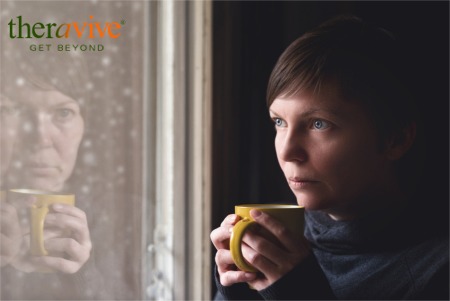 It is less than 3 weeks from the official start of spring yet 40% of the country is under winter advisories (Bacon, 2015). Boston have over 100 inches of snowfall, 5 more inches will break the record. The frigid start to 2015 is enough to give anyone the winter blues.
It is less than 3 weeks from the official start of spring yet 40% of the country is under winter advisories (Bacon, 2015). Boston have over 100 inches of snowfall, 5 more inches will break the record. The frigid start to 2015 is enough to give anyone the winter blues.
Winter Blues
Winter blues are more than a little sadness. According to the Diagnostic and Statistical Manual of Mental Disorders Fifth edition (DSM-5), seasonal affective disorder (SAD) is a form of recurring depression based on seasonal patterns (APA, 2013). The most frequent occurrence of SAD is during the winter months (Evans et al., 2013). The Mayo Clinic (2014) describes winter SAD symptoms as depression, irritability, fatigue, problems getting along with others, hypersensitivity to rejection, heavy feeling in legs and arms, increase in appetite, and weight gain.
The prevalence of SAD in adults ranges from less than 1% to 10% (Magnusson, 2005). The occurrence of SAD is highest in areas with more seasonal variability, in the latitudes furthest from the equator (Miller, 2005). Winter blues, not meeting criteria for SAD, occurs in up to 25% of adults living in the northern parts of the United States (Harvard Health). The symptoms include milder versions of SAD symptoms such as slight mood changes, increase in appetite, and decrease in energy.
The hormone melatonin, which acts as a neurotransmitter, is a key culprit in SAD (Miller, 2005). Melatonin is product of the biosynthesis of tryptophan and serotonin. This hormone is produced at night, signaling sleep, while natural daylight suppresses the production of melatonin; thus creating the circadian rhythm (Macchi & Bruce, 2004). According to the literature, individuals with SAD, as opposed to those without, produce melatonin for a longer period of time during winter months (Miller, 2005).
Furthermore, decreases in serotonin are associated with depression as well as carbohydrate cravings in SAD. Miller (2005) suggests that carbohydrate craving may be an unconscious way to stimulate serotonin production. The hypothesis would support the SAD symptom of hyperphagia, an abnormal increase in appetite. Donofry, Roecklein, Rohan, Wildes, and Kamarck (2014) conducted a study that tested this theory. They found that 30% of those with binge eating disorder also met criteria for SAD. It is hyposthesized that patients with SAD tend to crave carbohydrates in the evenings resulting in a phase delay of the circadian rhythm and an increase in retinal response to light (Danilenko, Plisov, Hébert, Kräuchi, & Wirz-Justice, 2008). Davis and Levitan (2005) purport that the symptom of carbohydrate craving and weight gain in winter may be the body’s way to treat SAD. More research is needed to support these assumptions.
On a genetic level, these symptoms may be related to evolutionary reasons for winter weight gain (Levitan et al., 2004). Researchers examined the relationship between a hypofunctional allele related to the dopamine-4 receptor gene and body mass index in women with SAD. The study revealed that 39% of the women with the anomaly exhibited binge eating while only 16% of women without the anomaly exhibited binge eating.
Treatment for SAD
There are two effective treatments, cognitive behavioral therapy (CBT) and light therapy (Evans et al., 2013). Light therapy reduces the production of melatonin. The increased exposure helps to mediate the shorter daylight hours of winter (Levandovski et al., 2013) while increasing the antidepressant effects of sunlight (Evan et al., 2013). This is a low cost and readily available treatment. A study by Rohan et al. (2013) exposed subjects with SAD to an ultraviolet light emitting 10,000 lux of white fluorescent light to the retina. The protocol had subjects sitting 18 inches from the lamp for 30 minutes each morning for 6-weeks. Light therapy works on a physiological basis whereas CBT targets the physiological front. CBT protocols incorporate behavioral activities and cognitive restructuring. CBT is a time-limited treatment and can be effective in 6 – 8 sessions. For Rohan et al. (2013) the protocol was twice weekly for 1 ½ hour sessions for 6-weeks with a trained therapist.
Although Putilov and Danilenko (2005) found the placebo effect to be quite high in a control group, light therapy is effective and widely accepted (Miller, 2005). In conclusion, while both therapies were effective, the psychological effects of CBT had a longer lasting effect in subsequent winters. Rohan et al. (2013) did not test for the combination of treatments it makes sense that time in the sun and cognitive restructuring would go a long way to combating the winter blues of 2015.
References
American Psychiatric Association. (2013). Diagnostic and statistical manual of mental disorders (5th ed.). Washington, DC: Author.
Bacon, J. (2015, March 3). March roars; Boston snow record poised to fall. USA Today. Retrieved from http://www.usatoday.com/story/weather/2015/03/03/winter-storm-snow-ice/24307617/
Danilenko, K. V., Plisov, I. L., Hébert, M., Kräuchi, K., & Wirz-Justice, A. (2008). Influence of Timed Nutrient Diet on Depression and Light Sensitivity in Seasonal Affective Disorder. Chronobiology International: The Journal of Biological & Medical Rhythm Research, 25(1), 51-64.
Donofry, S. D., Roecklein, K. A., Rohan, K. J., Wildes, J. E., & Kamarck, M. L. (2014). Prevalence and correlates of binge eating in seasonal affective disorder. Psychiatry Research, 217(1-2), 47-53. doi:10.1016/j.psychres.2014.03.012
Evans, M., Rohan, K. J., Sitnikov, L., Mahon, J. N., Nillni, Y. I., Tierney Lindsey, K., & Vacek, P. M. (2013). Cognitive Change Across Cognitive-Behavioral and Light Therapy Treatments for Seasonal Affective Disorder: What Accounts for Clinical Status the Next Winter?. Cognitive Therapy and Research, 37(6), 1201-1213. doi:10.1007/s10608-013-9561-0
Levandovski, R., Pfaffenseller, B., Carissimi, A., Gama, C. S., & Loayza Hidalgo, M. P. (2013). The effect of sunlight exposure on interleukin-6 levels in depressive and non-depressive subjects. BMC Psychiatry, 13(1), 1-8. doi:10.1186/1471-244X-13-75
Levitan, R. D., Masellis, M., Basile, V. S., Lam, R. W., Kaplan, A. S., Davis, C., & ... Kennedy, J. L. (2004). The Dopamine-4 Receptor Gene Associated with Binge Eating and Weight Gain in Women with Seasonal Affective Disorder: An Evolutionary Perspective. Biological Psychiatry, 56(9), 665-669. doi:10.1016/j.biopsych.2004.08.013
Macchi, M. M., & Bruce, J. N. (2004). Human pineal physiology and functional significance of melatonin. Front Neuroendocrinology, 25(3-4), 177-95.
Magnusson, A., 2005. The diagnosis, symptomatology, and epidemiology of Seasonal Affective Disorder. CNS Spectrums 10, 625–634.
Mayo Clinic (2014, September 12) Seasonal affective disorder (SAD): Symptoms. Retrieved on February 17, 2015.
Miller, A. (2005). Epidemiology, etiology, and natural treatment of seasonal affective disorder. Alternative Medicine Review, 10(1), 5-13.
Putilov, A. A., & Danilenko, K. V. (2005). Antidepressant effects of light therapy and “natural’ treatments for winter depression. Biological Rhythm Research, 36(5), 423-437.
Rohan, K. J., Evans, M., Mahon, J. N., Sitnikov, L., Sheau-Yan, H., Nillni, Y. I., & ... Vacek, P. M. (2013). Cognitive-behavioral therapy vs. light therapy for preventing winter depression recurrence: study protocol for a randomized controlled trial. Trials, 14(1), 1-11. doi:10.1186/1745-6215-14-82
About the Author

Dr. Amy Berwick
, PhD, LPC, NCCAmy is a Licensed Professional Counselor and adjunct professor at the University of North Carolina Charlotte. Her private practice focuses on life transitions using an existential theoretical orientation. In addition, she teaches both content and clinical courses to students working toward master degrees in clinical and school counseling. Amy’s research has been in the field of supervision, publishing and presenting on parallel processes and solution focused supervision.
Office Location:
1801 East 5th Street, Suite 213
Charlotte, North Carolina
28204
United States
Phone: 704-781-7072
Contact Dr. Amy Berwick
Professional Website:
www.counselorsofcharlotte.com